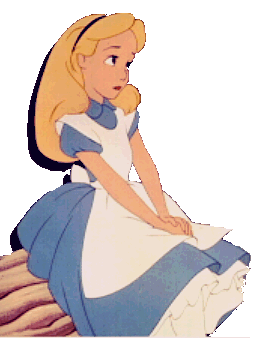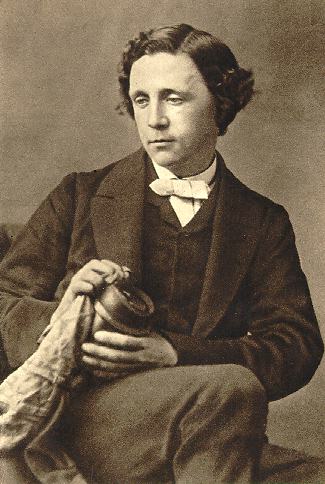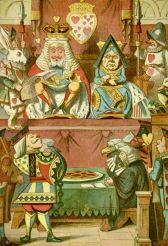
Cast * Interesting Facts * Production Details * The real Alice

Cast * Interesting Facts * Production Details * The real Alice
 Directed
by: Clyde Geronimi & Wilfred Jackson
Directed
by: Clyde Geronimi & Wilfred Jackson
Written by: Lewis Carroll
Music by: Bill Hilliard, Sammy Fain, Mack David, Al Hoffman
& Jerry Livingston
Released on: July 28, 1951
Running Time: 74 minutes
Budget: $3 million
Alice... Kathryn Beaumont
Mad Hatter... Ed Wynn
Cheshire Cat... Sterling Holloway (listen
Sterling talking about his role by clicking here!)
Queen of Hearts... Verna Felton
Walrus, Carpenter, Dee, Dum... Pat O'Malley
White Rabbit & Dodo... Bill
Thompson
Caterpillar... Richard Haydn
King of Hearts... Dink Trout
INTERESTING
FACTS

![]() At the beginning
of the movie, Lewis Carroll's name is spelled incorrectly on the animated
title page.
At the beginning
of the movie, Lewis Carroll's name is spelled incorrectly on the animated
title page.
![]() The movie was
Oscar-nominated for Best Music, Scoring of a Musical Picture.
The movie was
Oscar-nominated for Best Music, Scoring of a Musical Picture.
![]() Kathryn Beaumont, who was the voice of Alice, narrates the "Alice in Wonderland"
ride at Disneyland. She was also the voice of Wendy in Peter
Pan. Now Katherine Levine, she is a second-grade teacher
in Toluca Lake, California.
Kathryn Beaumont, who was the voice of Alice, narrates the "Alice in Wonderland"
ride at Disneyland. She was also the voice of Wendy in Peter
Pan. Now Katherine Levine, she is a second-grade teacher
in Toluca Lake, California.
![]() The talented Sterling Holloway (1905-1992, the Cheshire cat in Alice)
is best known as the voice of Winnie-the-Pooh. He also gave their
souls to some of the most funniest Disney characters, including Mr. Stork
in Dumbo (1941), Flower in Bambi
(1942), Kaa the snake in The Jungle Book
(1967) and Roquefort in The Aristocats
(1770). He was also the narrator of Peter and the Wolf (1946),
and Lambert the Sheepish Lion (1952).
The talented Sterling Holloway (1905-1992, the Cheshire cat in Alice)
is best known as the voice of Winnie-the-Pooh. He also gave their
souls to some of the most funniest Disney characters, including Mr. Stork
in Dumbo (1941), Flower in Bambi
(1942), Kaa the snake in The Jungle Book
(1967) and Roquefort in The Aristocats
(1770). He was also the narrator of Peter and the Wolf (1946),
and Lambert the Sheepish Lion (1952).
![]() Storyman Bill
Peet recalled in the late '90s that he "worked on just about every part
of that. The strange thing is that the person who worked on it last received
credit for a lot of my things. I developed the Caterpillar stuff, the Mad
Tea Party, the 'half a cup' gags and things like that. We wondered if it
could have been a little better in many little ways. We all disagreed with
the way it ended; with a montage. I didn't like it. I had developed a labyrinth,
and I was fascinated with the idea of the guards chasing Alice through
this thing. It could have been a hell of a thing with the music, like trying
to escape from a bad dream. but they decided to have everyone jump into
the tea pot in a montage. Montages don't do anything, and you don't want
to end with a conglomeration. You want suspense, where she's beating on
the door with just a minute left and just barely gets out of there."
Storyman Bill
Peet recalled in the late '90s that he "worked on just about every part
of that. The strange thing is that the person who worked on it last received
credit for a lot of my things. I developed the Caterpillar stuff, the Mad
Tea Party, the 'half a cup' gags and things like that. We wondered if it
could have been a little better in many little ways. We all disagreed with
the way it ended; with a montage. I didn't like it. I had developed a labyrinth,
and I was fascinated with the idea of the guards chasing Alice through
this thing. It could have been a hell of a thing with the music, like trying
to escape from a bad dream. but they decided to have everyone jump into
the tea pot in a montage. Montages don't do anything, and you don't want
to end with a conglomeration. You want suspense, where she's beating on
the door with just a minute left and just barely gets out of there."
![]() The Mello-Men
from Pirates of the Caribbean were the voices of the three cards
who were "painting the roses red" in Alice In Wonderland. Thurl
Ravenscroft, the voice of Tony the Tiger, is easily recognized as the Ace
of Clubs who says "in fact they'll soon be dead". The Mello-Men also
appeared in Lady and the Tramp.
The Mello-Men
from Pirates of the Caribbean were the voices of the three cards
who were "painting the roses red" in Alice In Wonderland. Thurl
Ravenscroft, the voice of Tony the Tiger, is easily recognized as the Ace
of Clubs who says "in fact they'll soon be dead". The Mello-Men also
appeared in Lady and the Tramp.
![]() A toony version
of the truly screwy Lewis Carroll poem "Jabberwocky"
was originally supposed to have been featured in the film. The sequence
featuring Alice's encounter with the creature which had flames in its eyes
and a smoke-stack nose, was storyboarded but never actually went into production.
Legendary writer/comedian Stan Freberg has however repeatedly stated in
interviews that he's given over the years that he actually recorded a version
of "Jabberwocky" for Disney--the only thing we know for sure is that this
part of the picture eventually ended up getting cut out!
A toony version
of the truly screwy Lewis Carroll poem "Jabberwocky"
was originally supposed to have been featured in the film. The sequence
featuring Alice's encounter with the creature which had flames in its eyes
and a smoke-stack nose, was storyboarded but never actually went into production.
Legendary writer/comedian Stan Freberg has however repeatedly stated in
interviews that he's given over the years that he actually recorded a version
of "Jabberwocky" for Disney--the only thing we know for sure is that this
part of the picture eventually ended up getting cut out!
 Walt
Disney had wrestled with the subject since 1933, when he contemplated a
version with Mary Pickford as a live-action Alice -color screen tests were
even made!
Walt
Disney had wrestled with the subject since 1933, when he contemplated a
version with Mary Pickford as a live-action Alice -color screen tests were
even made!
Years later, he planned to put Ginger Rogers in a cartoon Wonderland. Aldous Huxley at one time worked on a script. Walt abandoned again and again until finally he scheduled it to follow Cinderella.
He dropped the idea of a live-action Alice: "No matter how closely we approximate her with a living Alice, I feel the result would be a disappointment."
Back in 1939, Alice in Wonderland was being actively considered as the film that Walt Disney Studios would put into production as soon as work was completed on Pinocchio. David Hall did hundreds of inspirational paintings for Disney's first attempt to turn Lewis Carroll's acclaimed novel into an animated feature. But then World War II intervened, and production of Disney's Alice got pushed back 'til the early 1950s. By then, this feature had a very different style and tone than the European storybook look that Hall had originally proposed for the production.
The animated feature got terrible reviews when it premiered in England,
and Disney considered this project as one of the most difficult ones he
ever worked on. Disappointed with the film, he blamed its failure
on the heroine's "lack of heart."
 |
 |
 |
Alice Liddell was the original Alice of both Alice's Adventures in Wonderland and Through the Looking-Glass. Alice Liddell was born May 4, 1852, the daughter of Dean Henry Liddell of Christ Church Oxford in England.
Also at Christ Church was a mathematics instructor, Charles Dodgson. Dodgson wrote logic and mathematics books and was fond of photography.
It was in his role as photographer that Dodgson met Alice and her sisters, Edith and Lorina. Dodgson would visit the Liddells and photograph the children.
When he visited, he would tell the children stories that he made up. He was especially fond of young Alice. In July 1862, when Alice was 10, Rev. Charles Lutwidge Dodgson took the girls on a boating trip on the Thames River and passed the time telling a story about Alice's adventures underground -a delightful tale involving Alice and a White Rabbit.
One summer's day in July 1862, Lewis Carroll (Oxford Mathematics Lecturer,
the Rev Charles Lutwidge Dodgson) took three little girls, Alice and her
two sisters, on a boating trip. To keep them amused he told a delightful
tale involving Alice and a White Rabbit. That Christma, later published
as Alice's Adventures in Wonderland (1865), illustrated by Lewis
Carroll.

Little Alice loved the story so much that she asked him to write it
down for her to keep. That Christmas it was presented to Alice as
A
Christmas Gift to a Dear Child in Memory of a Summer Day. It
would be published in 1865, with illustrations by Lewis Carroll (Dodgson's
nom de plume) under the title Alice's Adventures In Wonderland with
illustrations by the author himself.
Alice was not the only real person to appear in Carroll's tales. The Duck was his friend Robinson Duckworth, who came along on many of the afternoon outings. Sisters Lorina and Edith Liddell were immortalized as the Lory and the Eaglet, and the Dodo was drawn from Dodgson himself (Dodo sometimes spoke with a st-st-stammer as in Do-do-Dodgson!).
As for Alice Liddell, she married Reginald Hargreaves in 1880. Alice was a distant relative of Queen Elisabeth II -her great-grandfather was brother of the ninth Earl of Strathmore, from whom Elisabeth II is directly descended. She died in 1934.
In June 2001, books, pictures and personal items once owned by the Alice
Liddell fetched more than $2.81 million.
|
||||||||||||